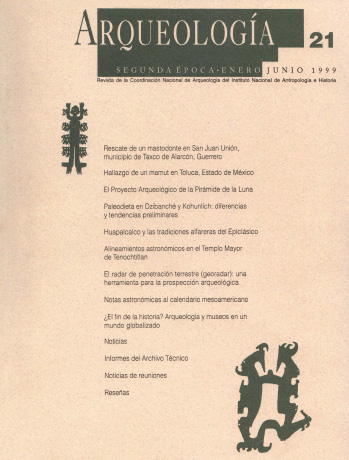Publicado 2018-07-17
Cómo citar
El Proyecto Arqueológico de la Pirámide de la Luna. (2018). Arqueología, 21, 19-33. https://revistas.inah.gob.mx/index.php/arqueologia/article/view/12236
Resumen
Sin resumenDescargas
Los datos de descarga todavía no están disponibles.
Referencias
- Blanton,R. E.,G.M. Feinmam,
- S.A. Kowalewski y P. N. Peregrine
- "A dual-processual theory for the
- evolut ion of mesoamerican civilization",
- en Current Anthropology 37 (1), pp. 1-14.
- Bernal,lgnacío
- Teotihuacan. Descubrimientos,
- Reconstrucciones, México, INAH.
- Cabrera C.,Rubén, George Cowgill
- y Saburo Sugiyama
- "El Proyecto Templo de Quetzal-
- coatl y la práctica a gran escala del
- sacrificio humano", en Amalia Cardós
- de Méndez (coord.), La Época Clásica,
- Nuevos Hallazgos, Nuevas Ideas, México, Museo Nacional de Antropología, INAH.
- "The Templo de Quetzalcoatl
- Project a Teotihuacan: a preliminary
- report", en Ancient Mesoomerica 2,
- pp. 77-92.
- Cabrera C.,Rubén y Oralia Cabrera
- "El Proyecto Templo de Quet-
- zalcoatl. Planteamientos generales y
- resultados preliminares", en Arqueología
- , segunda época, México, Dirección de Arqueología, INAH.
- Covarrubias, Miguel
- Indian Art of Mexico and Central
- America, Nueva York, Alfred E. Knopf.
- Cowgill, George
- "Rulership and the Ciudadela:
- política inferences from Teotihuacan
- architecture", en Richard M. Leventhal
- y Alan L. Kolata (eds.), Civilization in the
- Ancient Americas, Cambridge, University
- of New Mexico Press and Peabody
- Museum of Archaeology and Ethnology,
- Harward University, pp. 313-343.
- Kubler, George
- The Art and Architecture of
- Ancient America. Pelican History of Art.
- Manzanilla, Linda
- "The economic organization of the Teotihuacan priesthood: Hipotesis
- and considerations", en Janet Catherine
- Berlo (ed.), Art, Ideology, and the City of Teotihuacan, Washington , D. C. Dum-
- barton Oaks., Research Library and
- Colletion.
- Millon.René
- Urbonization at Teotiltuacan, Mexico,
- Part Two. The Teotihuacan Map, vol. 1, Alburquerque, University of New
- Mexico Press.
- "The place where time began. An archaeologist's interpretation of what
- happened in Teotihuacan history", en
- K Berrin y E. Paszcory (eds.), Teotihua-
- can Art from the City of the Goods, San Francisco, Thames and Hodson, The
- Fine Ares Museums of San Francisco,
- pp. 102- 164.
- Millon, René, Bruce Drewitt y James Benniyhoff
- The Piromid of the Sun at Teotihua-
- can: 1959 lnvestigations ,Philadelphia , Transactions of the American philo-
- sophical Society.
- Pasztory.Esther
- "El poder militar como realidad y retórica en Teotihuacan", en Arnalia
- Cardós de Méndez (coord.), la Época
- Clásico: Nuevos Hallazgos, Nuevas Ideas,
- México, Museo Nacional de Antropolo-
- gía, INAH, pp. 181-204.
- "Abstraction and the rise of a
- uropian state ar Teotihuacan", en Janet
- C. Berlo (ed.), Art ldeology and the City
- ofTeotihuacan, Washington , D. C.,
- Dumbarton Oaks., Research Library and Collection.
- Sugiyama, Saburo
- "Burials dedicated to the old
- Temple of Quetzalcoatl at Teotihua-
- can, Mexico", en American Antiquity 54,
- (1), pp. 85-106.
- "Rulership , warfare, and human
- sacrifice at the Ciudadela: and icono-
- graphic study of feathered serpent
- represenration s", en Janet C. Berlo
- (ed.), Art, ldeology, and the City of
- Teotihuacan, Washington, D. C., Dum-
- barton Oaks., Research Library and
- Collection.
- En prensa."Human sacrifice, militarism,
- and rulership at Teotihuacan, Mexico: materializacion of stace ideology in the
- feathered serpent pyramid", Universi-
- dad de Cambridge.

